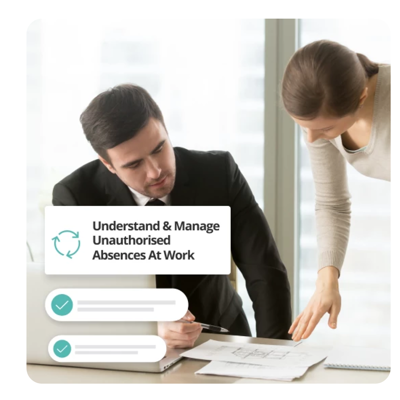How to Understand & Manage Unauthorised Absences At Work

In this guide, we’re going to explore how to manage unauthorised absence at work so you can make sure your internal processes are effective and compliant with UK legislation.
What is an unauthorised absence?
Managing an unauthorised absence procedure in the workplace
To ensure employees, managers, team leaders and HR professionals can reach a suitable, consistent resolution in the event of unauthorised absence, there needs to be a clear absence procedure in place.
1. Initial identification and documentation
When an unplanned absence is first suspected, it’s important to make some preliminary enquiries to check whether or not the absence is in fact authorised. This could include confirming annual leave bookings, or checking the employee’s last known communications to see whether they’ve mentioned being away from work.
Once it’s clear that the employee is absent without leave, make sure to document the date, time and any scheduled duties or responsibilities that the employee is missing. It might also be worth making note of any impact that the absence has on other employees’ workloads.
2. Contacting the employee
The next step is to make efforts to contact the absent employee to check their wellbeing and to find out the reason behind their absence. You can do this using whichever communication channels you have available, such as phone calls, emails and text messages, providing you have access to these contact methods for work-related purposes. Document every instance of attempting to get in touch with the employee, whether successful or not, for your records.
However, you should not contact an employee if they’re off sick, other than for reasons relating to your duty of care. If it’s been made clear that the employee is out of work for medical reasons, it’s best to leave them to relax and recover.
3. Return to work meeting
Once they return to work, it’s essential to conduct a return to work meeting to address any concerns that you or the employee may have. It’s best to do this as soon as possible after they come back so you can offer timely support for any issues that caused them to take unauthorised leave. This could mean addressing problems in the workplace, or offering reasonable adaptations to improve their work-life balance during a difficult time.
This meeting is also a chance for you to review company policies and make sure that the employee understands the correct procedures for taking leave, as well as any potential consequences of a repeat offence. Make sure to document the meeting, noting when it took place, who was present, and what, if any, outcomes have been agreed.
4. Formal communication
If the employee has another instance of unauthorised absence, the next step is to escalate the situation through formal communication. In this correspondence, you should clearly outline the company’s absence policy, as well as the potential implications of continued unauthorised absence. This could include disciplinary action, suspension or termination, as well as the conditions in which these would apply.
Make sure to use a written method of communication, such as letter or email, for ease of documentation. This will be essential evidence if the situation develops further and ends up leading to dismissal, helping you to prove a lawful precedent for termination.
5. Disciplinary action
Your absence policy should outline the amount and severity of unplanned leave that would lead to disciplinary action, as well as what the action taken for these would be. This should also have been communicated to the employee at their return to work meeting, and in any formal communication following unauthorised absence.
Disciplinary action may involve an HR investigation, for which any documentation relating to the employee’s unauthorised absences will be essential, as well as a hearing to decide the outcome. Depending on the circumstances, the appropriate unauthorised absence from work disciplinary action taken could be a formal warning, suspension or even dismissal.
6. Dismissal
Some employees may be wondering ‘can I be sacked for unauthorised absences?’
In short, yes. In extreme cases, an employer may decide to dismiss an employee due to unauthorised absences. This should always be a last resort and should come at the end of a fair disciplinary procedure, during which evidence of the misconduct shows grounds for dismissal.
It’s important that your company has robust procedures in place for unauthorised absences and disciplinary action, and that these are followed precisely and supported by relevant documentation. This will help you to build a case against the employee and avoid being liable for unfair dismissal.
Measures to prevent unplanned leave
To minimise the impact of unplanned leave on your workforce, it’s worth implementing some preventative measures to avoid it happening in the first place.
1. Developing a comprehensive absence management policy
A robust absence management policy will make sure that employers and employees are on the same page about leave, and what does and doesn’t constitute an authorised absence. It should clearly outline the entitlements and reporting requirements for annual leave, sick leave, and any other types of leave covered by company policies. An absence management policy can also help managers and HR professionals to notice the warning signs of unauthorised absences and take appropriate measures to prevent them.
2. Implement flexible working
Workers may take unauthorised leave due to unforeseen circumstances, or because they have a commitment that they don’t wish to use up their holiday allowance for. Offering hybrid working for your employees is a great way to help them to better manage their work-life balance and gives them the flexibility to take care of unforeseen issues by allowing them to work from home or outside core business hours.
3. Creating a positive workplace culture
Encouraging open communication and creating a positive workplace culture can help to prevent employees from taking unplanned absences. As well as giving them the confidence that they can discuss any issues they’re experiencing both within the workplace and in their personal life, it helps to create a more pleasant working environment where they enjoy spending time.
Effortlessly navigate unauthorised absences with PeopleHR
Managing unauthorised absences can seem overwhelming for small businesses, but having the right processes and tools in place can help to minimise the administrative burden and better support your employees. Absence management software not only allows HR teams and employees to book, authorise and keep track of planned absences like annual leave, but also supports unplanned absence procedures.
As a dedicated HR software provider for small businesses, PeopleHR understands the complexities of managing employees with limited resources. Check out our free trial to see our tools in action and experience first hand how they can support your business processes.

Related resources
We are trusted by experts

















































